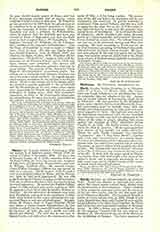

Napper (or NAPIER), GEORGE, VENERABLE, English martyr, b. at Holywell manor, Oxford, 1550; executed at Oxford November 9, 1610. He was a son of Edward Napper (d. in 1558), sometime Fellow of All Souls College, by Anne, his second wife, daughter of John Peto, of Chesterton, Warwickshire, and niece of William, Cardinal Peto. He entered Corpus Christi College January 5, 1565-6, but was ejected in 1568 as a recusant. On August 24, 1579, he paid a visit to the English College at Reims, and by December, 1580, he had been imprisoned. He was still in the Wood Street Counter, London, on September 30, 1588; but was liberated in June, 1589, on acknowledging the royal supremacy. He entered the English College, Douai, in 1596, and was sent on the mission in 1603. He appears to have lived with his brother William at Holywell. He was arrested at Kirtlington, four miles from Woodstock, very early in the morning of July 19, 1610, when he had on him a pyx containing two consecrated Hosts as well as a small reliquary. Brought before Sir Francis Eure at Upper Heyford (Wood says before a justice named Chamberlain), he was strictly searched; but the constable found nothing but his breviary, his holy oils, and a needle case with thread and thimble. The next day he was sent to Oxford Castle, and indicted at the sessions soon after under 27 Eliz., c. 2 for being a priest. The possession of the oils was held to be conclusive and he was condemned, but reprieved. In gaol he reconciled a condemned felon named Falkner, and this was held to aggravate his crime, but as late as November 2 it was believed that he would have his sentence commuted to one of banishment. As he refused the oath of allegiance, which described the papal deposing power as a “false, damnable, and heretical” doctrine, it was decided to execute him. He suffered between one and two in the afternoon, having said Mass that morning. His head according to Wood was set up on Tom Gateway; according to Challoner’s less probable statement on Christ Church steeple. His quarters were placed on the four city gates, but at least some were secretly removed and buried in the chapel (now a barn) of Sanford manor, formerly a preceptory of Knights Templar.
JOHN B. WAINEWRIGHT

